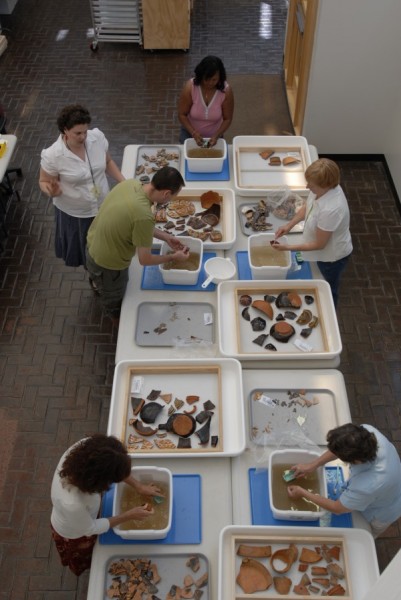The Archaeological Research Process
Back to PAF Home
Back to Archaeological Research in Philadelphia
A Brief Explanation of the Archaeological Research Process and its Reporting

In archaeology it is usually considered best practice to not excavate a site if there is no strong reason to do so. As part of this thinking, it is most ideal if the evidence from the past can be left intact in place for future generations of archaeologists who will have better methods than we have now. But that option is not always possible or even desired. Sometimes sites are in the way of modern needs and archaeological research can recover at least some of the endangered site’s information before the site is destroyed. Other times, questions about the past can only be solved with new archaeological evidence and so researchers elect to excavate a site in order to deepen historical understanding.
It is the excavation stage of archaeological research– or digging in the ground– that most comes to mind when people think of about archaeology. However, the excavation or ‘field discovery’ stage of archaeological research represents only the first 10% of any archaeological project. Archaeological research at any particular site–including a site in the city of Philadelphia–generally begins with an assessment of what evidence from the past might have survived the ravages of time. This stage of work involves historical background research, an evaluation of previous archaeological research in the area, and sometimes one form or another of exploratory testing that allows a quick peek into the ground (for examaple, a ground penetrating radar study). Based on the information gathered, a plan of action to undertake an excavation at the site might (or might not) be made.
When excavation of the site proceeds, the work may or may not produce archaeological remains. This recovered evidence often but not always includes artifacts which are objects related to the activities of people once living in the past. Often recovered along with the artifacts are features (namely remnants of structural elements built in the past) — such as water wells, privy (outhouse) shafts, house foundations, garden wall fence posts, or wharf footings.
Again, all this ‘discovery’ at the site location represents only the first 10% of any archaeological project. The majority of research on an archaeological project actually takes place after the excavation — when the data recovered in the field is taken to the lab to be cleaned, described, identified and then analyzed (interpreted) for its insights into the past.
This laboratory processing and analysis stage takes up the majority of the archaeological project’s time and effort.
Once processed and analyzed and interpreted, the archaeological evidence is always reported in a technical report. Occasionally, reporting of archaeological research is also made to the public. This stage of public reporting involves public interpretation, or the presentation, of the archaeological findings.
All of these stages of archaeological research produce archaeological documentation. This documentation is important. Archaeology is a destructive practice. An archaeological site is destroyed during excavation because the digging involves taking the site apart and removing its constituent elements –layers of soil, artifacts, etc. As a result, an archaeological site can only be dug once and archaeological site reporting stands in for the site that has been excavated. Archaeological reporting also records what happens to the evidence once it is in the lab, as well as the archaeologist’s final conclusions about what that evidence ‘means’ for understanding the past.
A brief history of Archaeological Research in Philadelphia
Types of Archaeological Reports
by admin
